Hello, My name is Rahil Joshi and I’m the founder and head of digital marketing at Web Zodiac. Today, we’re diving into the strategic depths of SEO, to analyze your competition and formulate a winning plan by creating an SEO competitor analysis report. Let’s explore the steps you should take and find out how you do competitor analysis in SEO to gain an edge, beat your competitors, and rank higher in SERPs.
Pre-requisite: You should know what is SEO.
What is Competitor Research in SEO?
SEO competitor research is the secret weapon that you use to outrank your competition and get more visibility in SERPs. It’s the blueprint for your competitors’ success, enabling you to understand what works for them and how your website can perform better. From keywords to content to backlinks, this SEO competitor analysis will help to strategize your way to the top of the SERPs and beat the SEO competition.
Why Competitor Analysis Is Important
In SEO, standing out is a challenging task because all are on the same page. Every business wants to secure the top spot in search engine rankings, which makes understanding your competition an integral part of successful SEO. Competitor analysis isn’t just about knowing who you’re up against; it’s about understanding their strategies, identifying their strengths and weaknesses, and leveraging this knowledge to your advantage.
Competitor analysis in SEO helps you to:
Identify Effective SEO Strategies: By analyzing successful competitors, one can understand the strategies that work in your industry. You can examine their keyword usage, backlink profiles, content strategy, and more, providing a roadmap of effective SEO tactics that you can incorporate into your own strategy.
Discover Untapped Opportunities: Competitor analysis can reveal gaps in the market – areas where your competitors aren’t performing strongly or vice versa. These gaps are opportunities for you to step in and excel, whether it’s targeting keywords that competitors have overlooked or creating content types that they’re not utilizing.
Stay Ahead of the Curve: SEO is always evolving, with new trends and algorithm updates often shaking up search engine rankings. Google started updating its algorithm every quarter now with core updates. By keeping an eye on competitors, you can stay agile, adapting strategies to keep up with industry changes and maintain a competitive edge over other players in the market.
Inform Strategic Decision Making: With comprehensive competitor analysis data, you can make informed decisions about your SEO strategy. This reduces the risk of wasted resources on ineffective tactics, A/B content testing and helps to prioritize the most impactful actions for your SEO success.
In essence, SEO competitor analysis helps you to outsmart, rather than outspend, your competition. It empowers you to optimize your strategy, make strictly data-driven decisions, and ultimately, climb higher in the search engine rankings.
Let’s Start SEO Competitor Audit
Great! This process might seem complex at first, but rest assured, it gets easier with practice. Remember, your primary goal should be finding opportunities to enhance the SEO strategy and beat your competition using competitor strategy. Let’s go on with the first step of SEO competitor analysis journey – finding your competitors.
Step 1: Identifying Your Competitors
No competition can be won without knowing the opponents, therefore start your SEO competitor analysis with the process of finding competitors. First, identify who your real SEO competitors are. They might not always be your business competitors, things in SEO space are a little bit different from offline market. The search engine especially Google is a big platform, and there’s a lot of noise to cut through. Here’s my approach designed over years, to categorizing SEO competitors:
- Primary Competitors: The big fish or rapidly growing startups in your market who sell exactly the same products or services as yours.
- Secondary Competitors: Businesses that might not be identical to yours but have overlapping product lines or services.
- Content Competitors: Not necessarily businesses, but they are creating content that competes for your audience’s attention.
Next, it’s time to use our friend, Google.
- We initiate an Incognito mode search

- With your top keyword and look at who’s appearing consistently in the top results.

These are your primary SEO competitors.

To take it a step further, you can use powerful SEO tools like Ahrefs and SEMrush. With these, conduct a more in-depth analysis of who’s competing with your website in the SERPs and even get insight into their strategies.
Step 2: Discovering the Keywords Gap
Now you have a list of your competitors, now it’s time to find the keywords that your competitors have obtained good ranking in search engine result pages. Keywords are your guiding stars in the vast universe of SEO. They show guide you to the path of money making, brand building, and customer acquisition, In order to show you how to find the keyword gap with your competitors, I have used SEMrush Keyword Gap Tool and a few websites as examples which were ranking higher on Google, in the top 4.
Following is step by step process to find differences in the number of ranking keywords and identify the best match for your website. This will provide you with a holistic list of keywords that should be used once SEO competitor research is done. So let’s jump into competitive SEO insights
- Log in to SEMrush, remember that you are doing competitor SEO analysis so please don’t go to the organic domain overview
- Go to the Keyword Gap tool on the left sidebar – Competitive Research > Keyword Gap

- Type in your domain and the domains of your competitors. Remember you can also use
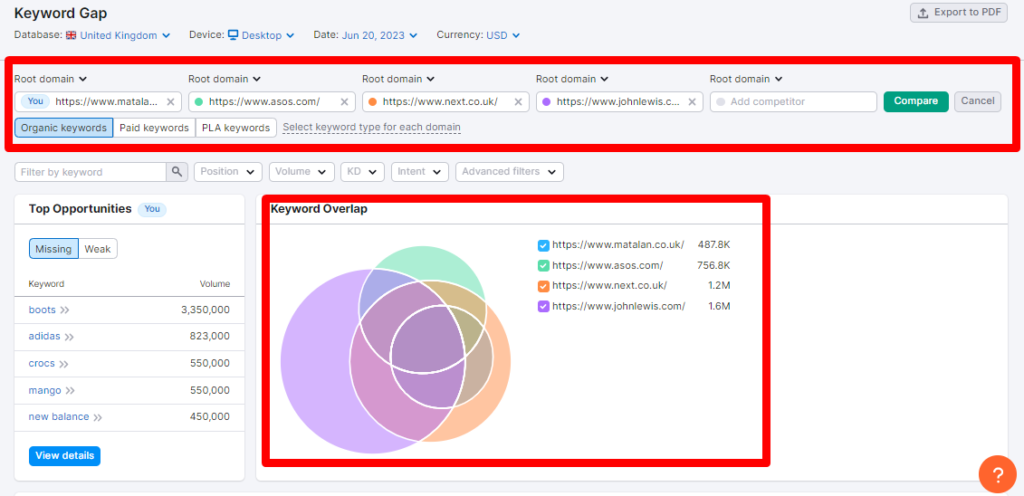
- First, look at the Shared Keywords. These are the keywords that you and your competitors are already ranking for.
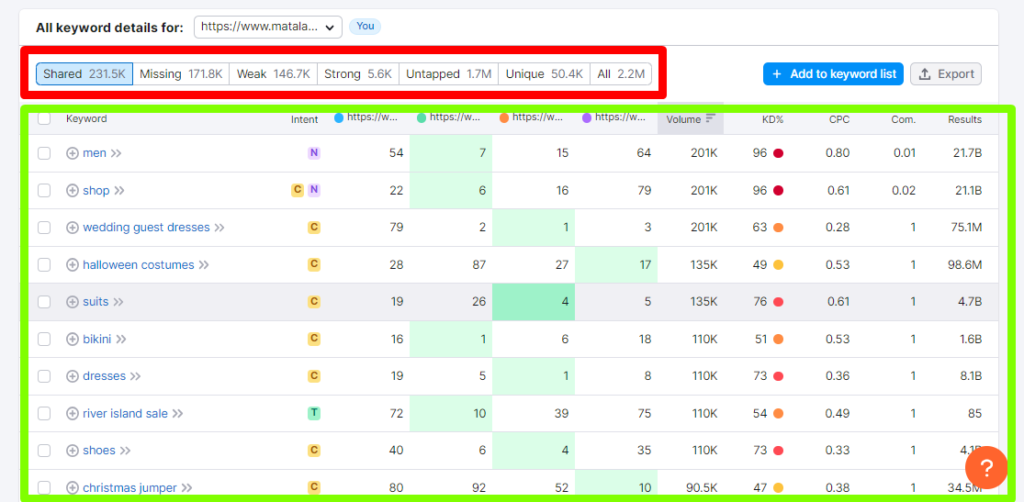
- Next, identify the Missing, Weak, and Untapped Keywords. These are opportunities you’re yet to seize. Missing keywords are keywords where all your competitors are ranking whereas untapped keywords are those where one or few competitors are ranking. Weak keywords are the keywords where you’re ranking below all your competitors.
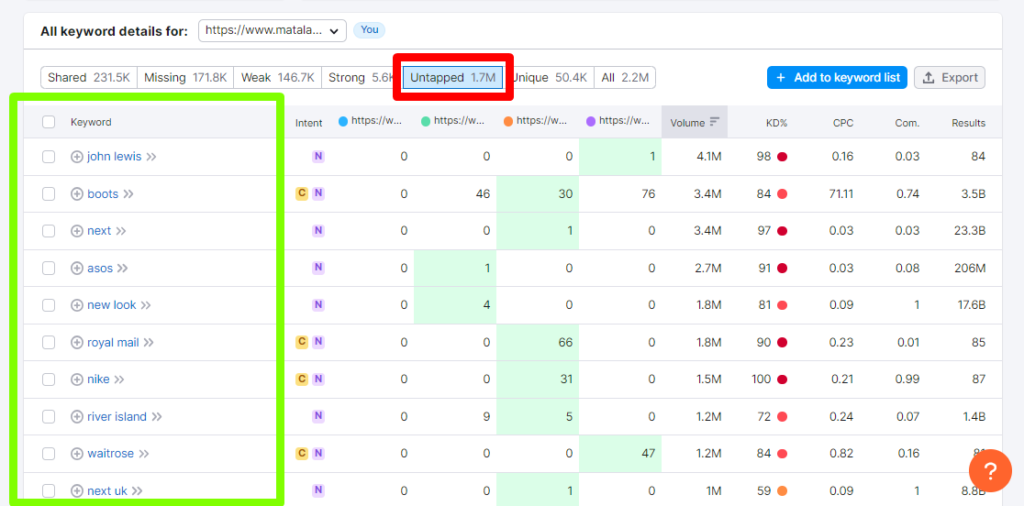
- Export these keywords, grouping them into relevant “buckets” or “categories”. Obviously, you don’t have to go for millions and millions of keywords at once.
- Start with Content Buckets, like product categories and blogs. Going for blogs is highly recommended. The beauty of SEO competitor analysis is that your competition has made all the efforts all you have to do is to replicate the keywords as per your choice and needs.
- This completes Step 2 of your SEO competitor analysis tutorial.
By identifying these keyword gaps, you can tweak your content and SEO strategy to fill these gaps and you will start ranking for new terms.
Find More About Competitor Keyword Research – 5 Step Expert’s Process To Find Competitor’s Keywords
Step 3: Analyzing the Content
In Step 3 of this SEO competitor analysis tutorial, you go for content that your competitors have curated. Now that you’ve found your keywords, it’s time to understand how your competitors are using them. You look at the various types of content they produce, such as:
- Blogs: These are regular updates or posts written in an informal or conversational style, providing insights, tips, or educational content relevant to your audience.
- Service Pages: These are pages on your website that detail the services you offer. They provide essential information about what your business does and how it can help potential customers.
- Articles: These are in-depth, researched pieces of content that offer valuable information on a specific topic, often referencing credible sources and providing expert insights.
- Category Pages: These pages organize your website’s content into different categories, helping users navigate your site and find the information they’re looking for easily.
- Product Pages: These are pages dedicated to individual products that you offer. They typically include product descriptions, prices, images, and potentially customer reviews.
- Infographics: These are visual representations of data or information, making complex information easier to understand and digest.
- Tutorials: Tutorials are instructional content that guides users through a process or task step-by-step, helping them to learn or accomplish something specific.
- How-to Guides: Similar to tutorials, these guides provide practical advice and tips on how to perform specific tasks or activities, making complex tasks manageable.
- Checklists: Checklists provide a list of tasks that need to be completed or points to be considered. They are often used as a practical tool to ensure nothing important is missed.
- News: These are timely, regularly updated content pieces that report on the latest events, developments, or updates in a specific industry or field.
You take note of their content length, page title, meta description, use of heading tags, how they structure their paragraphs, and overall content flow. All these factors give you an understanding of their content strategy and how you can craft better content to outshine them.
As you go one level deeper into the heart of your SEO competitor analysis, you focus on a meticulous evaluation of your competitors’ content. This isn’t a surface-level inspection; you conduct a thorough analysis covering essential elements that contribute significantly to SEO success. From understanding the content length to examining the meta descriptions, heading tags, paragraph structure, and overall content flow, you systematically uncover your competitors’ SEO strategies. These insights from SEO competitor analysis will help you craft an improved, tailored SEO approach aimed not just at matching, but exceeding your competitors. Now, let’s dissect these points of analysis to better understand their significance in your SEO journey.
Content-Length: Content length can directly impact SEO performance. Longer content usually provides more value to the reader, thus improving dwell time (how long a visitor stays on your site), a positive signal to search engines. You examine your competitors’ content length to determine the depth of detail they’re providing.
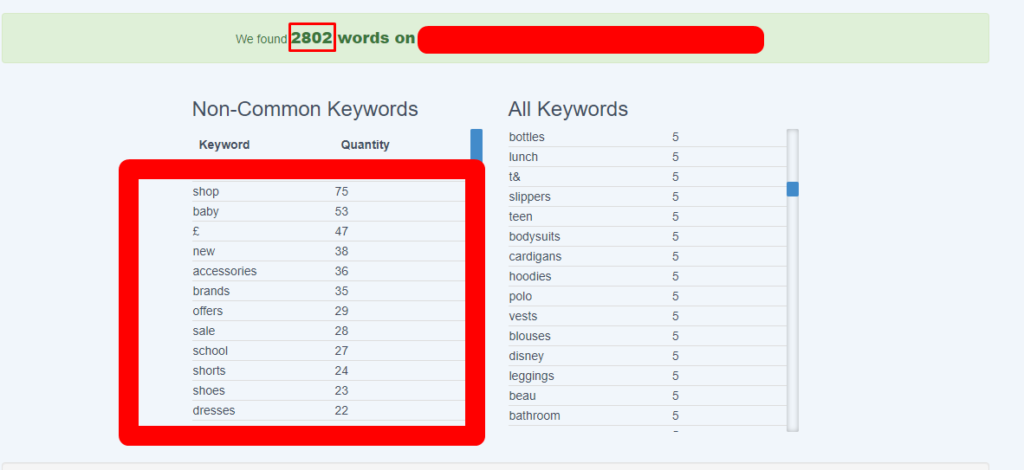
Page Title: The title of a webpage is a vital SEO element. It’s the first thing users (and search engines) see when looking at search results. You evaluate your competitors’ page titles to understand how they’re using keywords and generating interest.
Meta Description: The meta description is the small snippet of text that appears under the page title in search engine results. It can be a powerful tool for encouraging click-through-rate. You analyze your competitors’ meta descriptions for keyword usage and how effectively they convince users to click.

Heading Tags: Heading tags (H1, H2, H3, etc.) help structure content and give signals to search engines about the topic of the content. By studying your competitors’ use of heading tags, you can understand their content’s structure and how they emphasize their main and secondary keywords.

Paragraph Structure: The structure of paragraphs in web content impacts readability. Well-structured content is more likely to be read and shared. You should analyze how your competitors structure their paragraphs – are they short and snappy, or long and descriptive? This helps you to craft your content in a way that is most engaging for your audience.
Content Flow: The flow of content can be a determining factor in user experience. If a piece of content is logically and smoothly arranged, it makes for a better reading experience, keeping users on the page longer. By examining your competitors’ content flow, you understand the overall narrative structure they use, which informs how you might want to construct your own content.
By examining these factors in your competitors’ content, you’re able to gain insight into their content strategy. But, at Web Zodiac, your aim isn’t to merely match your competitors – it’s to outshine them. You take these insights and use them to create superior content for your clients: content that provides more value, resonates more deeply with their audience, and ultimately, outranks your client’s competitors in the search engine results.
Step 4: Creating an Action Plan Based on Step 2 and Step 3
Here comes step 4 of this SEO Competitor Analysis. Now you have found the keywords and content to go after, now what’s next. After you’ve identified your competitors and the keywords we’re competing for, it’s time to bring all of that research to fruition in the form of a solid, actionable SEO plan. This is where you can truly start to see the fruits of your hard work and invested time. By strategically implementing your findings, you can significantly improve your SEO results.
The information that you have gathered so far is a goldmine. But data alone isn’t powerful; it’s how you use it in a way that can truly drive change. Your action plan consists of two key parts: addressing Untapped, Weak and Missing Keywords.
- Weak Keywords: These are keywords that both you and your competitors rank for. Unfortunately your competitor is ranking higher on these keywords. Now your part of the job is to outrank those and achieve higher ranking in SERP comparing the competition. To leverage this, follow these
- You need to analyze how your competitors have used these keywords in their content.
- Are they in the headings?
- Are they using in the metadata or the first paragraph of their content?
- You scrutinize your competitors’ keyword placement strategy and use this knowledge to optimize your pages accordingly.
- Ensure that you are doing this in an authentic manner. Please don’t copy paste the content, else, Google will kick you out of search.
- Directly copying a competitor’s keyword placement could lead to duplicate content issues and wouldn’t add value to your site’s visitors. All you are looking to understand the strategy and apply it uniquely to your content.
- Missing and Keywords: These are the keywords that all your competitors rank for, but you don’t.
- Identifying these keywords gives you an insight into potential opportunities you’re missing.
- For missing keywords, you analyze the type of content that your competitors have created around these keywords.
- Is it a blog post?
- A product page?
- An infographic?
- Based on this analysis, you decide on the type of content that you should create.
- As you curate new pages, you keep in mind that adding value for your audience is your top priority.
- Ensure that you are not just stuffing these keywords into a page; you are providing relevant, valuable information around these keywords.
- This not only helps you rank but also provides a better user experience for your visitors.
Remember, your goal with this action plan isn’t just to replicate what your competitors are doing. Instead, you aim to understand their strategy, learn from it, and create an even better SEO strategy for your own website.
In addition, your action plan isn’t static. The search algorithms are continually evolving, and so should your strategy. You consistently revisit your action plan, using ongoing SEO competitor analysis to keep it relevant and effective.
By implementing this action plan, you can see a tangible improvement in your search engine rankings. The higher you rank, the more visibility you get, ultimately leading to more traffic and potential conversions on your site.
Step 5: Uncovering Backlink Gaps
Now coming to final stepBacklinks, the currency of the internet. The more backlinks you have from reputable sites, the more Google will trust you, and the higher you’ll rank. But remember the keyword, “Reputable Sites”, if you get 1000 backlinks from spammy sites, more you’re are prone to penalty. In this step, you shift your focus from keywords to backlinks. Finding high quality sites that your competitors are ranking for and get acquire backlinks from those domains.
Let’s
- Log in to SEMrush.
- Go to the Backlinks Gap tool just below keyword gap

- Enter the URL of your target page and the URLs of your competitors’ equivalent pages.
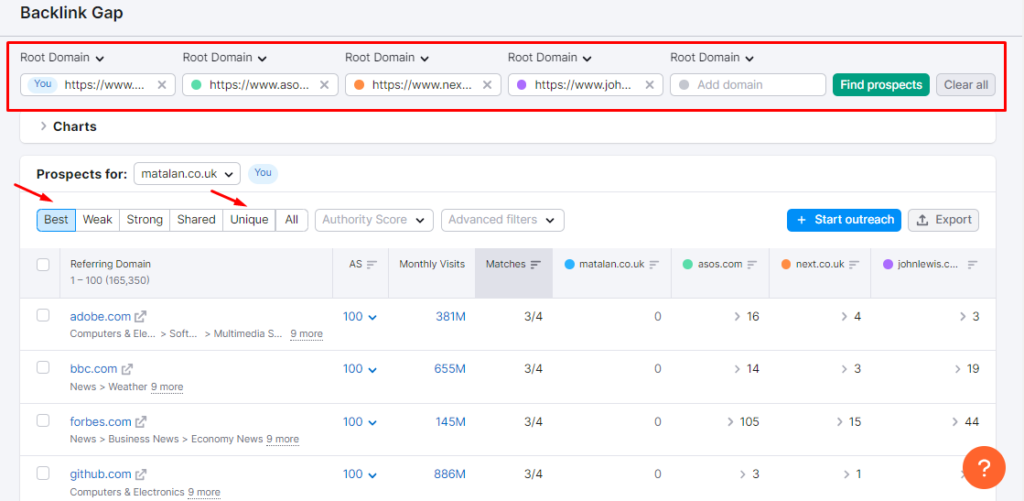
- From the data, identify the unique domains that are linking back to your competitors but not to yours.
- Export this list and begin strategizing on how you can acquire backlinks from these valuable domains.
Conclusion
Conducting an SEO competitor analysis is like unlocking a treasure map. It shows you where the gold is and how you can get there before your competitors do. At Web Zodiac, we’ve mastered the art and science of SEO competitor analysis, always staying ahead of the game.
By performing a detailed analysis of your SEO competitors, identifying keyword and backlink gaps, scrutinizing their content, and creating an action plan, you’re all set for success. As a result, you improve your rankings, increase your visibility, and drive more organic traffic to your website.
Remember, SEO is not a one-and-done strategy. It requires constant monitoring, adjusting, and refining. With SEO competitor analysis, we ensure that we’re always moving in the right direction, adjusting your strategy as needed based on data, not guesswork. So if you’re ready to step up your SEO game, feel free to explore our SEO Services page, where we offer customized solutions for businesses like yours.


0 Comments